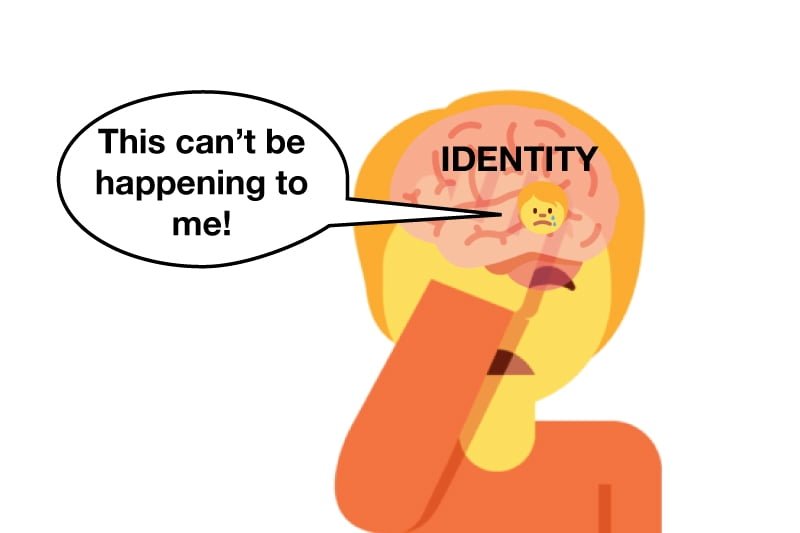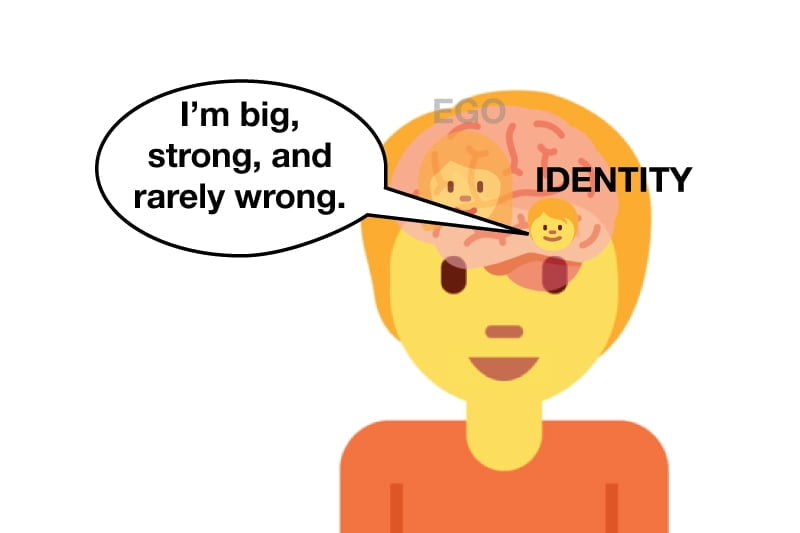Self-justification is your ego shielding your identity from reality like an overprotective mother coddling her delicate child.
Everyone does it.
Including you.
And it messes with your reality. As Carol Tavris and Elliot Aronson reveal in one of my favorite mind-changing books, Mistakes Were Made, But Not By Me, self-justification:
- Ruins relationships
- Turns good people bad
- Makes scientists go mad
- Deceives detectives
- Completely rewrites our memories
- And turns us into close-minded losers with inflated egos.
What makes self-justification especially insidious is this:
The less you believe you’re affected by self-justification, the worse you suffer from it.
So the first step to fighting self-justification?
Accept that you do it all the time.
That starts with understanding exactly how you self-justify. This post’s step-by-step explanation and multiple examples will help you do so.
Then, maybe—hopefully—you can catch your ego in the act and stop it before it makes your identity even softer and more deluded than it already is.
In This Guide to Self-Justification

The Step-by-Step Self-Justification Process
Imagine this scenario:
You just finished watching the latest Fast and the Furious sequel at the theatre and get into your car to drive home. Since you, like most people, think you’re an above-average driver, you think to yourself, “I could have been a stunt driver in another life.” You sit down, put on your podcast, start your engine, pull out of your parking spot, and…
Screeeeeech!!!
You sideswipe a pole, leaving a nasty gash on the passenger side of your car.
“F*&@!!!“
That’s self-justification’s cue to get rolling.

Self-Justification Step 1:
Cognitive dissonance threatens your feeble identity.
Upon scratching your car, you feel an immediate sense of disbelief and uncertainty. This is called cognitive dissonance.
Tavris and Aronson define cognitive dissonance as “a state of tension that occurs whenever a person holds two cognitions (ideas, attitudes, beliefs, opinions) that are psychologically inconsistent.”
In the case of your self-inflicted sideswipe, your two inconsistent cognitions are:
| Cognition A | Cognition B |
|---|---|
| “I’m an above-average driver” | “I just grated my car against a pole that even a legally blind grandma could have avoided.” |
The uncertainty of this clash of cognitions makes your delicate identity tremble. It needs the reassurance of a clear and simple reality, not this complex dilemma.
Something has to be done to resolve it.

Self-Justification Step 2:
Ego comes to the rescue with lies and excuses.
In a flash, your ego, like an overprotective mom, jumps in to soothe your identity and assess the damage.
It sees the two inconsistent cognitions causing discomfort to your precious identity. Then it deftly whips out its favorite band-aids to salve the discomfort:
Lies and Excuses:
“Don’t worry, my precious little identity. It wasn’t your fault.”
- “They should have painted that pole bright yellow so it doesn’t blend in with the walls around it.”
- “You were tired from a long day of being amazing.”
- “Didn’t you notice that your arm involuntarily spasmed, causing the steering wheel to jerk to the left and direct the car toward the pole. We should get you some pills to address that.”
Your precious little identity takes great comfort in the bosom of this BS. But it remains shaken from the experience.
Self-Justification Step 3:
Confirmation bias brings extra comfort.
Since your identity continues to tremble from the unfortunate sequence of events, your ego goes the extra mile to comfort the poor thing.
To do so, it uses confirmation bias, “the tendency to search for, interpret, favor, and recall information in a way that confirms or supports one’s prior beliefs or values.”
These are your ego’s three go-to confirmation bias tactics:
- Seeking “evidence” to back up its weak excuses.
Your ego googles known manufacturing defects of your car and finds a Reddit thread full of fellow above-average drivers who complain about the faulty sensors that are supposed to warn you of objects like poles.
- Tearing conflicting clues to shreds.
What about the other dents and scratches on your car from earlier incidents?
“Not relevant,” assures your ego. It has stories to explain away all of them.
- Fudging your memory.
As you drive out of the parking lot, your ego “reminds” your identity, “The car on your other side was way over the line and pinned you in! And you were already parked super close to the pole. There was almost no way you could have got out without scratching it.”
And every time your identity takes the bait, your ego embellishes the story a bit more.
At last, your effete identity’s dissonance dissolves.

Self-Justification Step 4:
Warped memories become your reality.
“’I have done that,’ says my memory. ‘I cannot have done that,’ says my pride, and remains inexorable. Eventually—memory yields.”
Nietzsche.
Time passes, memories blur, and your wimpy runt of an identity completely forgets the lengths your ego went to to protect it.
In its place, your identity fully believes a fabricated version of events that conveniently lacks the slightest hint of dissonance.
So when your friend asks you a few months later if you’ve ever had any mishaps while driving, this is how you might respond:
“Only once. I was super hyped-up from watching Fast and the Furious and exhausted from a crazy week or work. Some jerk-off parked so close to me that I was pinned against a pole. Maybe the movie desensitized me to the cost of damaging my car or something, but rather than spend what would’ve taken half an hour to squeak out unscathed, I said, ‘screw it,’ and accepted the inevitable scratch on the side of my car. It barely cost anything to repair, anyway.”
The Self-Justification Vortex
On its own, one instance of self-justification is no big deal.
The problem is these aren’t one-off events. Our egos keep busy protecting our feeble identities with self-justifying excuses, lies, confirmation biases, and memory distortions day, every day.
Every time self-justification happens:
- Your ego gets stronger. By shielding your identity, your ego validates its presence. What’s more, the hard work makes it bigger and stronger than before, and ever more vigilant and proactive against further danger.
- Your identity gets feebler. Like a timid weakling of a child who’s allergic to everything and not allowed outside to “roughhouse” with other kids, your identity gets increasingly soft, susceptible to injury, and disconnected from reality.
The stronger your ego and feebler your identity, the more the latter is prone to cower behind the former for protection.
And so goes the self-justification vortex.

Our egos become overbearing behemoths, our identities become so fragile that the slightest scratch sends them into convulsions, and we descend further and further away from reality into a self-justified world of our own creation.
Stop Your Spiral
See the companion to this post, How to Stop Justifying Yourself and Start Living in Reality, for anti-self-justification strategies.
And review the following examples to solidify your grasp of the four-step self-justification process.
Self-Justification Examples
Example #1:
Forgetting a Birthday (Unhappy Marriage)
Reality: Your husband tells you he forgot to buy you a birthday present.
- Cognitive dissonance:
- Cognition A: “I’m a very important part of my husband’s life.”
- Cognition B: “I’m so low on my husband’s priority scale that he didn’t even remember my birthday.”
- Lies and excuses: “I’m super easy to buy gifts for.”
- Confirmation bias:
- Admitted evidence: “Earlier in our relationship, he made a big deal out of my birthdays, and I loved it. Clearly, things have changed.”
- Destroyed evidence: “He’s very clearly remorseful and doing his best to make it up to me with a massage and plans to go on a romantic weekend away.”
- Embellished Memories: “I gave him tons of unsubtle hints about what I wanted for my birthday, but he didn’t pay attention because he only cares about himself.”
- Warped reality: “I have a selfish prick of a husband who doesn’t give a crap about me anymore.”
Example #2:
Forgetting a Birthday (Happy Marriage)
Reality: Your husband tells you he forgot to buy you a birthday present.
- Cognitive dissonance:
- Cognition A: “I’m a very important part of my husband’s life,” versus
- Cognition B: “I’m so low on my husband’s priority scale that he didn’t even remember my birthday.”
- Lies and excuses: “He was so busy with work and the kids that it makes total sense he might forget. In his position, I would have done the same. Plus, I don’t care about my birthday, anyway.”
- Confirmation bias:
- Admitted evidence: “He’s very clearly remorseful and doing his best to make it up to me with a massage and plans to go on a romantic weekend away.”
- Destroyed evidence: “Earlier in our relationship, he made a big deal out of my birthdays, and I loved it. Clearly, things have changed.”
- Embellished Memories: “I barely beat an eye when he told me that he forgot about my birthday. We pretty much laughed it off. My husband’s presence is a gift in itself.”
- Warped reality: “My husband cares about me more than anything else in the world. I feel the same about him. His quirky forgetfulness is part of why I love him.”
Watch Self-Justification in Action on Netflix
Example #3:
Splurging a Fancy New Car
Reality: You spend more than you should on a car.
- Cognitive dissonance:
- Cognition A: “I’m a winner at life.”
- Cognition B: “I got sucked into this purchase by a salesman, social pressure, and vanity.”
- Lies and excuses: “This car’s safer and will save you time getting to and from work. You’re a boss for negotiating well below the sticker price.”
- Confirmation bias:
- Admitted evidence: “See? This car magazine rewarded it ‘Best of the Year.’ And you noticed those people admiring you in it, right?”
- Destroyed evidence: “Other magazines rated another car half the price just as highly. And most people aren’t noticing me in my car at all.”
- Embellished Memories: “I had decided I was going to buy the car before I even walked into the dealership. The salesman didn’t impact my decision one iota.”
- Warped reality: “Splurging on this car was a smart move.”

Example #4:
Feeling Uneasy About Eating Insects
Reality: You’re served fried flying ants as an appetizer at a fancy restaurant and feel a bit nauseous when you eat one.
- Cognitive dissonance:
- Cognition A: “I’m always rational, open-minded, and adventurous.”
- Cognition B: “If I were truly rational, I wouldn’t have any problem eating these bugs.”
- Lies and excuses: “It’s not because I have an irrational prejudice. Flying ants are an acquired taste that I never developed. Anyway, it’s the spices that I don’t like. They’re too strong.”
- Confirmation bias:
- Admitted evidence: “The server said he didn’t like the flying ants much, either, so they obviously don’t even taste that good.”
- Destroyed evidence: “Lobster and oysters are essentially the same, and I pay premium prices to devour those with glee. Also, the table beside us ordered a second plate of these flying ants.”
- Embellished Memories: “There was so much other food on the table that you could only eat a couple to save your appetite for the rest.”
- Warped reality: “I didn’t mind the flying ants much at all because my tastes are totally rational.”
Example #5:
Learning About Self-Justification
Reality: You just read a blog post telling you that you have an inflated ego, fragile identity, and skewed sense of reality because of self-justification.
- Cognitive dissonance:
- Cognition A: “I’m pretty level-headed and in touch with reality.”
- Cognition B: “Apparently, the less I believe I’m affected by self-justification, the worse I suffer from it.”
- Lies and excuses: “This post is intended for people who have issues, not me. Plus, the guy who wrote this is exaggerating to keep my attention and has no idea what he’s talking about.”
- Confirmation bias:
- Admitted evidence: “When I last made a mistake, I didn’t make up lies and excuses to defend myself.”
- Destroyed evidence: “My friends, spouse, and family would have no problem pointing out blatant acts of self-justification I’ve been guilty of.”
- Embellished Memories: “I already knew everything there is to know about self-justification before reading this.”
- Warped reality: “The fact that I read this post proves that I’m the type of person who’s in touch with themselves and truth-seeking, so my life isn’t affected much by self-justification.”
Keep Resisting the Self-Justification Vortex
I highly recommend reading Mistakes Were Made, But Not By Me for an entertaining and eye-opening exploration of self-justification and how it affects all aspects of life.
Mistakes Were Made (But Not By Me): Why We Justify Foolish Beliefs, Bad Decisions and Hurtful Acts, by Carol Tavris and Elliot Aronson
Also, try some of the strategies in the companion to this post, How to Stop Justifying Yourself and Start Living in Reality.
And check out these other practical guides to psychology:
About the author
👋 I'm Chris. Everything you read on TheZag.com is my fault. This site is like a gym for your comfort zone, full of challenges to make your status quo sexier. Join my 'Consider This' newsletter for a fun new challenge every 10 days. Try it!





Leave a Comment